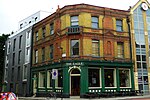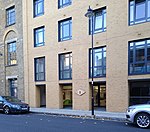Postal Museum, London
2004 establishments in EnglandArchives in the London Borough of IslingtonBuildings and structures in ClerkenwellHistory museums in LondonMedia and communications in the London Borough of Islington ... and 7 more
Museums established in 2004Museums in the London Borough of IslingtonPhilatelic museumsPhilately of the United KingdomPostal museumsRoyal MailUse British English from August 2015

The Postal Museum (formerly the British Postal Museum & Archive) is a postal museum run by the Postal Heritage Trust. It began in 2004 as The British Postal Museum & Archive and opened in Central London as The Postal Museum on 28 July 2017.
Excerpt from the Wikipedia article Postal Museum, London (License: CC BY-SA 3.0, Authors, Images).Postal Museum, London
Calthorpe Street, London Clerkenwell (London Borough of Islington)
Geographical coordinates (GPS) Address Nearby Places Show on map
Geographical coordinates (GPS)
| Latitude | Longitude |
|---|---|
| N 51.524 ° | E -0.1126 ° |
Address
London Central Mail Centre (Mount Pleasant Mail Centre)
Calthorpe Street
WC1X 9HX London, Clerkenwell (London Borough of Islington)
England, United Kingdom
Open on Google Maps










